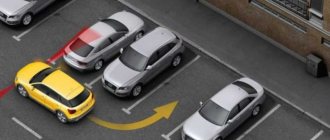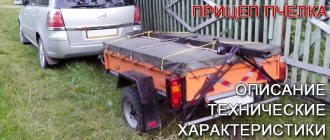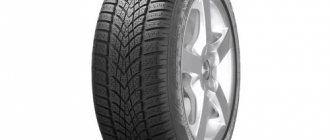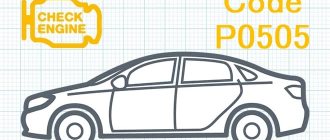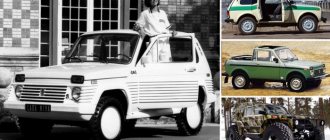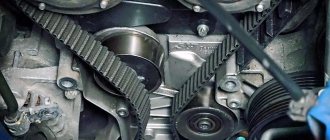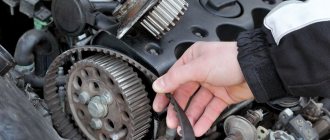Most novice motorists, even after graduating from a driving school, cannot perform reverse maneuvers correctly. This happens because there is little time allocated to perform such a movement. However, in everyday life, reversing is not used as often as, for example, normal driving. But you need to be able to do it in any case. In connection with this, we have prepared our article in which you will familiarize yourself in detail with all the nuances of parking and entering the garage in reverse gear.
Driving according to the rules
If you follow the existing rules, then driving in reverse on the road is permitted. But the motorist must be very careful and not create significant obstacles for road users. It is expressly prohibited to engage in driving that may restrict the maneuvers of vehicles standing behind. As for the speed and duration of such movement, the rules say the following - the movement must be slow and short-lived. There are no special characteristics given, so you don’t have to be afraid of traffic police officers, but keep in mind that you shouldn’t cross several populated areas in reverse gear.
If there is a pedestrian or other vehicle behind you, you must sound a sound signal in order to prevent a collision. But if you don’t submit it, then don’t worry, you won’t be fined for this, since this is just a recommendation, and not a mandatory rule. Professionals advise turning on the sound alarm, although this action is not written in the rules, it’s just that the car will thereby attract the attention of everyone around you, at any time of the day or night. For this reason, law enforcement agencies will not be able to bring any charges against you.
Naturally, there are also areas where driving in reverse is prohibited. In this regard, the following signs are installed:
- "No entry".
- "Movement Prohibition".
If you ignored the first sign, you may be fined 500 rubles, but if you ignored the second sign, you will have to pay ten times more, and you may be deprived of your rights for a period of 4 to 6 months. If reversing is done on a one-way roadway, then this maneuver is not a violation and a reason for punishment. However, once you get to the lane where the route transport travels, you cannot avoid a fine ranging from 1,500 to 3,000 rubles, it all depends on the place where the tragedy occurred.
The rules also say that such movements are prohibited in those places where the driver is not allowed to turn his vehicle around, and it does not matter whether this is established by markings or a sign. There are still some sections of the road where driving in reverse gear can result in an accident. The following can be distinguished from them:
1. Overpass, overpass or bridge.
2. Areas with visibility on both sides of no more than 100 meters.
3. Motorway.
4. Tunnel.
5. Moving.
6. Stop of minibuses and buses.
7. Crossroads.
8. Pedestrian crossing.
If you do not have a special need, then you should not drive in reverse during heavy precipitation, thick fog or other climatic conditions that limit the visibility of the path.
Following the advice of law enforcement agencies, it is recommended to always be attentive and careful when reversing in parking spaces, near the exit from the yard, and not far from the parking lots of large supermarkets. If you believe their words, then this is where accidents most often occur, and the culprits are not experienced drivers. In addition to all this, they recommend carefully inspecting everything around before engaging reverse gear. Because this action can prevent unpleasant situations that very often arise due to nerves and fear.
MOTORIST
Home — Driving Lessons
I have never climbed Mount Everest, but I guess the path to the top is long and difficult.
Driving a car also has its peaks that are worth striving for, but the path to them is measured in months and years of daily conscious driving. The pinnacle of driving skill includes not only the techniques of driving a car in the most difficult car racing conditions, but also the seemingly ordinary ones - towing, overtaking and reversing.
Yes, yes, reversing is one of the pinnacles of driving skill. Of course, you can successfully pass the traffic police exams by driving into the box in reverse without knocking down the pillars. But which of you, after the exam, will, firstly, dare, and secondly, be able to successfully reverse into an ordinary “shell” (mini-garage), and even the first time? Would all of you risk backing up your car about 100–200 meters on a narrow road with heavy traffic?
“Well, I can. And what? Is this a problem or what?" - only an unreasonable “newbie” who just received his driver’s license yesterday can say this.
“Yes, now I can do that too! No problem!" - and this is what an “old man” will say, who has successfully driven his car on the roads for a long period of time and acquired one very important quality.
At some point in his driving life, the driver suddenly feels an inextricable connection between himself and the car, between his thoughts and the car’s behavior on the road. Hands are the steering wheel and front wheels, legs are acceleration and deceleration, the interior of the car seems like home, where everything is familiar and controllable even with your eyes closed, and the car goes exactly there and the way the driver thought and planned.
Each of you will definitely come to these sensations, just give it time. And this period depends on your determination to reach the heights of mastery. Someone will be able to achieve this in a year or a year and a half, or maybe earlier. Some people have a long way to overcome the ledges of automobile Everest. But anyone can reach the top.
Now, from the sky-high heights, let's return to earthly everyday life. Let's look at some of the problems with reversing.
The first “surprise” that awaits you when reversing is that you will be able to move backwards “in a straight line” only when you learn to turn!
Don't believe me? It's easy to check! Try to drive in reverse for 20–30 meters, keeping the car straight in some real or imaginary corridor.
So how many meters later did your car suddenly turn off the straight line and go in the wrong direction? In ten? Fifteen? I think no more. Now let's find out why this happened.
When you look in an ordinary mirror, you usually don’t think about the fact that everything in it is upside down, because you’re used to it. And if, for example, you need to cut off a couple of extra hairs on your face with scissors, and “under the spine”? If you haven't tried it, try it and then you will understand that it is not easy to do. For some reason the scissors are turning in the wrong direction! You wanted to turn them so that they flatly touched the skin of your face, but they turned the other way and ended up completely sideways.
About the same thing happens when driving in reverse. It seemed to you that you needed to turn the steering wheel a little “that way,” but it turned out that you should have turned it in the other direction. This happens because, when moving in reverse, the driver perceives himself and his car in the world around him not entirely correctly and cannot immediately coordinate the actions with his hands with the direction of movement of the car.
Firstly, the driver does not see his hands, which in itself is already unpleasant.
And secondly, often “newbie” drivers do not take into account the fact that when reversing, the rear wheels become steerable! In fact, just as the front wheels were steerable, they remained so. But in the direction of travel they are now backwards!
You should know that forklifts and other self-propelled transport trolleys, which have to constantly maneuver while moving around factories and warehouses, are steered by the rear wheels! This was done specifically to increase the maneuverability of forklifts in tight spaces.
In a normal car, when reversing, when the front and rear wheels change roles, the slightest movement of the steering wheel leads to a significant change in the direction of movement! Getting the car to move backwards in a straight line is not easy. You have to constantly work the steering wheel, turning it a little bit, now to the right, now to the left. But this is something you don’t know how to do yet.
Now let's talk about how your hands should work at a significant angle of rotation of the steering wheel, for example, when driving into a garage.
Figure 68 shows the correct position of the hands on the steering wheel. Only this position (not higher or lower) ensures maximum precision of hand movements, allows the driver to feel the road on the steering wheel, and makes it possible to apply small and large forces to the steering wheel. But all this while moving forward!
Rice. 68. Correct hand position on the steering wheel
I suppose you can guess that when reversing you need to look backwards. Moreover, you need to see the entire situation as the car moves. To do this, you will have to stand up slightly, turn your torso to the right and back as much as possible and sit half sideways. Then the viewing sector will be maximum, and your neck will not get tired.
But what about your hands? Oh, aren’t they comfortable now? So find a comfortable position for them.
If you search carefully, the only suitable position for the hands will be that shown in Figure 69.
Rice. 69. Driver's position when reversing
“Yes, it’s convenient! But how to steer now? – this is your question. And my answer is in Figure 70.
We will steer with one hand!
Rice. 70. Turning the steering wheel with one hand
So, let's get ready to turn right. Before you start steering, you need to correctly orient your palm on the rim of the steering wheel. I suggest you “spread” your fingers, place your left palm on the steering wheel, rest lightly on it and twist your hand left and right. At some point, the palm seems to fall into a hole. In fact, it is the steering wheel rim that has taken its intended place in the folds of your palm. Now you can release the tension in your fingers and lightly hug the steering wheel.
Next, resting your right hand on the back of the seat and applying some force with your left hand, we begin to turn the steering wheel to the right. When the steering wheel is turned almost 180° (Fig. 70, item 3), your left hand will begin to feel discomfort - it cannot rotate the steering wheel any further! This is a signal for you to straighten (“spread”) your fingers, slightly increase the pressure with your palm on the rim of the steering wheel and, while continuing to turn the steering wheel, turn your hand counterclockwise (Fig. 70, pos. 3–4).
Keeping your fingers straight and resting your palm, you continue to turn the steering wheel further. As soon as the hand passes the lowest point (Fig. 70, item 4), it will be possible to slightly release the pressure of the palm and lightly hug the rim of the steering wheel with your fingers (Fig. 70, item 5).
Then, without much effort, you turn the steering wheel to the initial position (Fig. 70, item 6), from which you can continue turning and make another turn of the steering wheel or return the steering wheel back. It’s very easy to continue, you just need to repeat the steps described above. Putting the steering wheel back is also easy, the steps are the same, you just need to do them in reverse order.
I am sure that after a short practice you will like this method of steering. Not only does it ensure continuous rotation of the steering wheel with maximum speed and accuracy, it also frees up your right hand! When moving backwards, it occupies the only comfortable position - on the back of the right front seat. When moving forward, for example, when driving through a courtyard area with numerous maneuvers, an extra hand will also not hurt you. And to successfully reverse into the exam “box” and into your own garage, the ability to work with one hand is simply necessary!
This was a turn back to the right, with only the left hand working. To turn back to the left, you just need to turn half-side to the left in your seat and change hands - move your right one to the steering wheel, and tuck your left one in your elbow on the back of your seat. Everything else remains unchanged - we turn the steering wheel, “spread” our fingers, scroll the brush, and so on.
It is better to train in winter. Based on the fact that you will have to work thoroughly with your hands, you should provide maximum freedom to the front wheels of your car. And what could be better than slippery ice! Therefore, drive your car to some quiet place where a compassionate janitor has not yet sprinkled salt on the shiny mirror of a frozen puddle, and start training.
What if it’s... July?!
Then I advise you to purchase the “Health” or “Grace” CDs. Yes, yes, these are the same discs with the help of which our lovely ladies improve their figure by spinning back and forth on them. Believe me, these discs can easily withstand not only representatives of the “fairer sex”, but also a significantly larger load.
By placing one disc under each of the front wheels, you will ensure very easy rotation of the steering wheel. Next, all you have to do is spend some time training.
If, when reversing, you try, without changing the position of your body, to leave your hands on the steering wheel in their original position (Fig. 68), then you can steer with both hands, but where will the car go?
A person cannot turn his head like an owl! Consequently, you will not be able to control a large sector of the road behind you! The invisibility zone may include cars, pedestrians, exam stands and other objects that would be better seen. On the road, this is fraught with an accident, and in the exam, complete failure.
Rice. 71. Options for turning using reverse: a) reasonable; b) unreasonable
Which picture (Fig. 71) do you think shows a safer option for turning around using reverse gear? On the top or on the bottom?
On the top, for three reasons!
Firstly, the less distance you drive in reverse, the fewer problems you will have.
Secondly, turning left is always more difficult than turning right. And if this is a left turn in reverse, then in terms of technique it is not just more difficult, but much more difficult than turning right.
And finally, thirdly. In the top picture, the driver is looking over his right shoulder when moving backwards. This means that he can simultaneously control the trajectory of his car and the entire traffic situation on the roadway along which he moves and turns.
In the bottom picture, when reversing, the driver is forced to look behind him over his left shoulder. Will he be able to simultaneously maintain the intended trajectory and control the cars approaching this place from both sides? He can if he spins on the seat like a spinning top, then in one direction, then in the other. But not everyone succeeds, especially in the first years of driving a car.
- Before reversing, the driver must take a comfortable position on the seat, allowing him to control the largest possible sector of the road in the direction of travel.
- When planning a turn using reverse and side passage, you should choose a trajectory in which the car will travel the shortest distance in reverse.
Of course, the driver must master all the techniques of driving a car, but these techniques must be mastered not on busy city highways, but somewhere on a training ground or on a deserted dead-end section of the road.
Determine for yourself personally (not for exams) the range of your problems in driving a car, allocate time, find a suitable place and practice. Moreover, try to implement different versions of the same exercises. Do not stop at the results achieved in the driving school and in the traffic police exams. Only the creative process of learning the science of driving a car and independent training can lead the driver to the heights of driving skill. return to contents “Driving Lessons”
Let's start practicing driving in a straight line
Every skill needs constant training. As a result, before leaving for the city, practice proper driving in reverse. First, you need to master driving in a straight line without using mirrors. To do this, turn your head back and control everything that happens on the road through your right shoulder. It should also be remembered that correct driving in a straight line will depend on the position of the steering wheel. Even with slight movement of the steering wheel, the car will move to the sides. In this regard, it is very important to drive at low speeds.
How to control reversing
To learn how to ride in reverse, first adjust your seat position. First, you need to set up your seat so that you can press the brake or gas in any situation, even if your body is slightly turned when you move backwards. The seat position should allow you to easily and comfortably turn and look over your right shoulder, while still being able to apply the brakes and stop quickly if necessary.
If you need to drive in reverse for a long time, it's best to move the seat closer to the steering wheel and then move it back again when you need to drive straight.
After adjusting the seat, mirrors and checking the seat belt, you can start moving backwards. Depending on the type of car you have, you can do this in one of several ways. Your car's transmission shift mechanism is located either on the steering column or on the floor; Depending on the car model, the transmission can be automatic or manual.
- Option 1: Automatic transmission on the steering wheel. For vehicles with a steering wheel-mounted automatic transmission, the brake must be depressed when engaging reverse gear. Do not take your foot off the brake or turn until you are in reverse.
- Option 2: Automatic transmission on the floor. The same goes for cars with automatic transmissions with a floor shifter. Hold the brake and move the gearshift down and into reverse.
- Option 3: Manual transmission on the floor. For a car with a manual transmission, the floor-mounted reverse is opposite fifth gear and usually requires an additional downward push.
When using a manual transmission to drive in reverse, your left foot should press the clutch while your right foot operates the gas and brake.
Driving in reverse using mirrors
When you have mastered driving backwards with your head turned, you can continue to train only with the use of mirrors. First you need to adjust the mirrors correctly. The owner of the vehicle is obliged to control the situation happening behind him and this must be done with the help of rear-view mirrors. Having acquired good skills, all motorists use only mirrors and no longer turn their heads.
How to learn to make turns
Every experienced motorist should be able to make not only reverse movements, but also any turns. Remember one thing: you cannot change the direction of movement in reverse gear. Simply put, when turning the car to the right, the steering wheel should be turned in the same direction. This rule is the same for both forward and reverse control.
A very important point remains to learn how to set the minimum radius of the rear wheels at the moment the vehicle turns 90°. You should train on an area with a soft surface, for example, sand is very suitable. First, stop the vehicle and get out of it, try to mentally mark the center on the rear wheel, exactly on the side in which you are going to turn. Then you need to get back into your car and engage reverse gear, while turning the steering wheel all the way. Start driving smoothly until your vehicle turns 90 degrees.
Your next action will be to get out of the car again. Calculate the approximate radius of your turn and place any object near the previous mark that will symbolize the pointer. Get back behind the steering wheel and, looking in the mirrors, make the turn. This action must be performed slowly, and until you notice the pointer in the side vision mirror.
Subtleties and nuances when driving a car with a manual transmission
First of all, when you start to slow down in a car, do not forget that when the speed decreases significantly, you must depress the clutch. Without this, after characteristic twitching, the car engine will stall in gear.
It is also worth noting that in case of slight braking, it is permissible not to depress the clutch, but only if the correct relationship between the driving speed and the selected gear is not violated.
For this type of braking, the following must be taken into account:
- to reduce the speed of the car, you must stop pressing the gas pedal;
- go from a high gear to a low gear, while pressing the clutch (for example, go from fifth gear to fourth);
- Gradually reduce the speed, moving from the highest gear to the lowest. Follow this principle until you reach the first gear.
In order to practice this method of braking a car, a large area will be required. To find out what gear and speed you have, just look at the scales of the measuring instruments (tachometer and speedometer).
For example, at the moment when second gear is engaged, and the arrow on the tachometer has approached the red zone (red stripes), in this case you need to switch to third gear. If the speed is low (below 1800 thousand rpm), and the gear is fourth, then it is worth reducing the gear to third.
In any case, each car is different in engine type, power, weight, etc. In this case, the following ratios of speed and gears can be considered as an average indicator:
- First gear: 0 – 20 km/h;
- Second gear: 20 - 40 km/h;
- Third gear: 40 – 60 km/h;
- Fourth gear: 60 – 80 km/h;
- Fifth gear: 80 km/h and more;
- Sixth gear (not available on all manual transmissions) - 100 km/h or more.
If your car's speed is high enough, then the transition from low to high will occur smoothly. However, when switching “down” you need to remember that this will lead to a slowdown. Moreover, if you switch at high speed, for example, from fifth to second, this can lead to a sharp deceleration, skidding, and breakdown of the gearbox and engine.
However, you need to understand that coasting is unsafe, since the force from the box is not transmitted to the drive wheels. Also, after driving in neutral and then shifting into gear, you need to take into account the speed that the car has already reached. If the speed is over 50 km. per hour, it is possible to immediately switch to fourth gear, and when about 30 km. per hour, on the second or third.
Important nuances
The first thing you need to do before you start driving in reverse is to find a suitable training area. Experienced motorists do not recommend practicing in areas where there is active traffic, because this can lead to an accident. There are cases when, due to lack of care and experience, the driver is caught by poles with lanterns and cars standing nearby. However, this is not the worst thing that can happen. It will be much worse if you run into a pedestrian, and to prevent this from happening, choose places where there are no people.
Mirrors can deceive
You should not 100% trust the mirrors on your car. Such a source only shows additional information about what is happening near your vehicle and has only a limited overview. It is very difficult to see something in the mirror, even if a pedestrian or vehicle is moving next to you.
So, use two options for moving in reverse. Use not only one mirror, but also your vision. When turning back, looking over your right or left shoulder, you can easily control the current situation on the road. Only this way will you get the best overview. But there are also inexperienced motorists who believe that this position is not entirely comfortable for driving. This opinion is wrong, and after doing a few training sessions, you will be convinced that this is the best position for moving in reverse.
Lowest speed
Always remember that moving backwards is only allowed at low speeds. To do this, you will need to release your pressure on the clutch pedal until the vehicle begins to move. When you need to increase the speed, you should release the pedal a little, but not all the way. Because when the car is moving fast, you will not be able to see what is happening on the road. To reduce speed, you just need to press the clutch pedal harder. If it suddenly turns out that this is not enough, then try pressing the brake. Driving in reverse gear is a bit like driving at low revs.
General principles of driving a car with a manual transmission
First of all, you need to study in advance the features of a manual transmission on a specific car. At the training stage, you should pay attention to the following points:
- make sure that the car is located on a level surface, the parking brake (handbrake) must be applied;
- Depress the clutch pedal all the way;
- For safety reasons, so that the car does not jerk after starting the engine and releasing the clutch, check the gear (at the very beginning the lever should be in neutral position).
- After turning the key and starting the car engine, continue to fully depress the clutch, but at the same time, the gear from “neutral” must be switched to first (direction to the left and up);
- Before removing the car from the handbrake, you must press the brake with your right foot;
- then you need to assess the road situation through the side mirrors and the interior rearview mirror. Having made sure that it is completely safe, we begin to carefully and smoothly release the clutch, while simultaneously removing our right foot from the brake and lightly pressing the gas pedal. As a result, the car will start moving.
If you release the clutch ahead of time, jerking will follow and the car will stall. Late release of the clutch also becomes a common occurrence, after which a sharp jerking of the car and a jump in revolutions cannot be avoided. Only practice will help a beginner develop the habit of “feeling” the moment the clutch engages.
If your car engine stalls, follow the following procedure:
- First of all, the car must be put on the handbrake;
- Then set the gear to neutral;
- Depress the clutch all the way and at the same time press the brake pedal, then turn the key and start the engine. Then you need to try to get underway again.
Once the vehicle has started moving, it is important to consider the following when driving:
- Never change gears while the gas pedal is depressed;
- at the moment of transition to the next gear, without pressing the gas pedal, depress the clutch. This will allow you to disconnect the motor from the gearbox and make it possible to switch to the desired gear;
- Having selected the gear you need, switch to it. As a rule, gears need to be switched one at a time, but with experience in certain conditions, switching through 1 step is allowed. During the learning process, jumping through one gear (for example, from first gear directly to third) is unacceptable;
- Having engaged the desired gear, you can release the clutch pedal, and not as smoothly as when starting off in first.
- to switch the gearbox to second, third and other gears, you should increase the speed to 3000-4000 rpm and accelerate sufficiently;
Maneuvers and stopping
When reversing, you need to take into account the fact that the front part of the car is always thrown to the side. For example, if you turn left, the front wing will tilt to the right. As a result, when performing any maneuvers, you need to control that the part that moves does not hit nearby cars or other obstacles.
Inexperienced motorists often make the mistake of dropping the clutch at the end of the drive without disengaging the gear. After this, the transport begins to move in a different direction. Thus, you can damage someone else's car, crash into a curb and even into the walls of a garage. To avoid emergency situations, carefully monitor your actions.
74-70-69
As practice shows, drivers do not pay too much attention to this maneuver. However, improper reversing often leads to accidents, the most common of which are hitting a pedestrian and colliding with a car. And if the consequences of collisions are often limited to vehicles receiving various mechanical damage, then in collisions with pedestrians, the latter receive serious injuries that can lead to death.
Since the beginning of 2022, in the city of Bryansk there have been 6 collisions with pedestrians when a car was moving in reverse. As a result of these road traffic accidents, 1 person was killed and 5 were injured of varying degrees of severity. It should be noted that all injured pedestrians are people of retirement age.
Reversing is a very dangerous maneuver for the driver, during which it is necessary to strictly follow the requirements of the Road Traffic Regulations.
Rules for driving in reverse: In the rules of the road, the features of driving in reverse are described in paragraph 8.12: 8.12.
Reversing a vehicle is permitted provided that this maneuver is safe and does not interfere with other road users. If necessary, the driver must seek the help of others. Those. Reversing is permitted only if it does not interfere with other cars, motorcycles, pedestrians and other road users. In the event of a difficult traffic situation, paragraph 8.12 suggests using the help of other persons, which can be both passengers in your car and pedestrians passing by. In practice, you can ask the pedestrian to make sure that when reversing you do not hit other cars or other obstacles. In addition, your assistant can signal to approaching vehicles and they will allow you to complete the maneuver. Situations in which reversing is prohibited: • at intersections; • at pedestrian crossings; • in tunnels; • on bridges, overpasses, overpasses and under them; • at railway crossings; • in places where road visibility in at least one direction is less than 100 m; • in places where route vehicles stop; • on highways. How to avoid an accident when driving in reverse - If a car is moving in reverse towards you, do not engage in reverse under any circumstances.
Use the beep. Any adequate driver, upon hearing the sound signal, will stop reversing. Don't forget about the sound signal. At the very least, you will attract the attention of witnesses who will help prove your innocence in the future. — If you are reversing and hear a beep, be sure to stop. It’s better to linger for a couple of minutes, get out of your car and inspect the traffic situation than to hit someone else’s car. — When reversing, look alternately at all rear-view mirrors. — When driving between parking rows, carefully watch for cars to your left and right. This is especially important in a situation where you make a forced stop to let an exiting vehicle pass. — Use reversing when you are in no hurry. In relation to parking at a store, this means that the best solution is to calmly park the car backwards into a parking space before going to the store, and after visiting the store, calmly drive out in front. Dear drivers! Maximum composure, concentration and, of course, strict adherence to traffic rules are the key to trouble-free driving! Be careful when driving!
All the pros and cons
When you have the opportunity to use the forward move to perform any maneuvers, then take advantage of it, even if you make more movements. Driving in reverse is very dangerous, but it contains some advantages:
1. High maneuverability.
2. Easy parking even from an awkward position.
3. With a small parking space, it is convenient to monitor the space to the neighboring vehicle.
Precautionary measures
When driving in reverse, it is recommended to unfasten your seat belt and use the proper turn signals. Even in difficult conditions (poor visibility, narrow parking space, heavy traffic), it is necessary to turn on the emergency signal. By doing so, you will inform all road users of your intentions, and this action will facilitate easy exit.
Now we can definitely say that you have mastered the reverse technique. After practicing for a few days, you will be able to maneuver back without much effort. It is very important not to forget about three rules:
- Do not hurry.
- Monitor the position of the wings of vehicles.
- Maneuver using mirrors.
In addition, do not forget to look back for more effective control over what is happening. Such actions will help you avoid an accident. Be careful and attentive and you will succeed.
